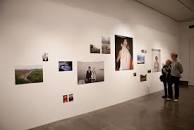Photographic space
 The reproduction of space by the artist is analytical. Creating a certain disposition of objects and figures on the plane, he sequentially builds depth, going from one spatial plan to another. The orientation of our eyes in space is based on a clearly fixed consciousness of verticals and horizontals – no tilting of the observer’s head creates a visual sensation similar to the effects of shooting with a camera tilted up or down. In the same way, the gaze directed into the distance tends to “straighten” somewhat, rationalize space. He involuntarily gives objects indefinitely turned to him more distinct positions, leading to the frontal plane of their face or profile. And even in the transmission of sharp angles, direct perception softens the severity of promising shape reductions, reduces the visual imbalance of the parts of the object that are distant and close to us. Of course, visual “corrections” are completely alien to the artificial eye of the camera. The space of a photo image is a purely perspective, foreshortening system. And therefore, the experienced eye easily distinguishes a drawing or engraving made from a photograph from natural ones.
The reproduction of space by the artist is analytical. Creating a certain disposition of objects and figures on the plane, he sequentially builds depth, going from one spatial plan to another. The orientation of our eyes in space is based on a clearly fixed consciousness of verticals and horizontals – no tilting of the observer’s head creates a visual sensation similar to the effects of shooting with a camera tilted up or down. In the same way, the gaze directed into the distance tends to “straighten” somewhat, rationalize space. He involuntarily gives objects indefinitely turned to him more distinct positions, leading to the frontal plane of their face or profile. And even in the transmission of sharp angles, direct perception softens the severity of promising shape reductions, reduces the visual imbalance of the parts of the object that are distant and close to us. Of course, visual “corrections” are completely alien to the artificial eye of the camera. The space of a photo image is a purely perspective, foreshortening system. And therefore, the experienced eye easily distinguishes a drawing or engraving made from a photograph from natural ones.
These differences are especially sharply revealed in photographs taken with an inclined apparatus – from above, from below. For a long time, photo art, focusing on the usual forms of pre-photographic images, avoided photographs of this nature. But interest in the specifics of photo language in the 1920s leads, on the contrary, to the cultivation of a sharp angle (especially in the works of A. M. Rodchenko and other constructivist photographers). Such photographs claimed new ways of visual orientation in space. They emphasized the dynamic nature of vision, the movement of the gaze as if materialized in the tilts or turns of the camera. The feeling of the depth of space – and not only horizontally, but also in vertical and inclined directions – intensified dramatically. The reference visual coordinates of space – horizontal and vertical – losing their stability, tilted and warped. And this – at first completely unusual for the audience – spatial structure retained its authority absolutely “correct”, conveying the real nature with documentary accuracy.
In fact, the photographic transmission of space is neither absolutely adequate to the nature of human vision, nor even unambiguously specified by the very “nature” of photography. After all, it’s enough to change the focal length of the lens (the operation is completely inaccessible to the “unarmed” human eye) to obtain completely different scale and spatial relations of objects in the image, and to a certain extent, a different plastic form. The ratio of sharpness in different planes of the image is easily changed, and this also changes the perception of spatial depth. The photographic space is controllable and can vary in relation to various artistic tasks. However, in all these changes, the spatial specificity of the photographic image is preserved. Its active three-dimensionality cannot be completely eliminated even from images specially flattened, for example, with the help of a telephoto lens, enlarging and pushing forward long-range plans, or due to the appropriate choice and organization of nature (frontal photograph of a vertical wall, silhouette, etc.).
Photography stands out among other visual arts also in its special relationship with time, no less specific than its relation to space.
The very first experiments of “instant” photographing showed astonished spectators an unexpected and unusual world of suddenly interrupted movement, unstable poses, unfinished gestures – a world taken by surprise, having little in common with the rather conventional static nature of “ordinary” fine art. It immediately became clear that the horse does not run as artists see, synthesizing several moments of movement in one drawing in order to convey its integrity; and people actually move differently than they themselves thought.
The stopped movement can sometimes be very expressive precisely because of the unexpectedness of the moment, it can become a powerful means of elimination, affirming an unusual perception of well-known things. But still, our spectator habit tends to break out of the frame of a moment, continue the action, linking the snatched phase of it with previous and subsequent ones. One way to do this is to hunt for a nonrandom instant that concentrates the most characteristic qualities of movement. The art of the photographer partly returns such pictures to a less fragmented, synthetic time of the drawing.



